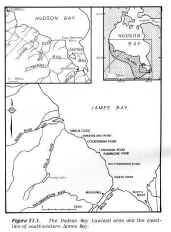|
In: The Coastline of Canada, S.B. McCann. (Ed.); Geological
Survey of Canada. 1980, 293-301
GEOMORPHOLOGY OF SOUTHWESTERN JAMES BAY: A LOW ENERGY,
EMERGENT COAST
I.P. MARTINI1, D.W. COWELL2, and G.M. WICKWARE2
1Department of Land Resource Science, University of Guelph, Ontario
2Lands Directorate(Ontario Region), Environment Canada, Burlington,
Ontario
 The
southwestern coastline of Hudson and James bays in Ontario and Manitoba is
the longest low gradient, emergent shoreline in the world. It maintains an
uninterrupted offshore slope of about 0.5-1 m/km over a distance of
approximately 1700 km. The land has been subjected to active rebound for
the last 7000-8000 years, and is still rising at a rate of less than 1
m/100 years. The
southwestern coastline of Hudson and James bays in Ontario and Manitoba is
the longest low gradient, emergent shoreline in the world. It maintains an
uninterrupted offshore slope of about 0.5-1 m/km over a distance of
approximately 1700 km. The land has been subjected to active rebound for
the last 7000-8000 years, and is still rising at a rate of less than 1
m/100 years.
The Ontario coast consists of three main morphologies: coasts dominated by
abundant parallel beach ridges and spits; coasts dominated by estuarine
systems; and coasts with promontories and transverse ridges.
All three types of coastlines are represented in the
southern part of James Bay. Longitudinal beach ridges fringe upper tidal
flats on the southern and eastern sides of promontories and in areas where
storm waves are not greatly attenuated by extensive sandy flats. The
longitudinal ridges vary in elevation from 1.5-2 m (composite sandy and
gravelly ridges), to 0.3-0.5 m (coastal single sandy bars), and in sandy
flats to 0.2 m (sinusoidal sand waves). Promontories and transverse ridges
are related to bedrock highs or glacial depositional features modified by
deposition of coastal sands and gravels. A marked counter-clockwise marine
current in the southern part of James Bay redistributes the fluviatile
materials to the southeast of estuaries, onto extensive, featureless, low
lying tidal flats.
With emergence,
incorporation of these features into the peatland complex is manifested
through a progressive paludification of the landscape, and in older parts
of the Lowland. Only high ridges and promontories (higher than 1 m) with
well-developed coniferous forests, remain as recognizable coastal
landforms.
|